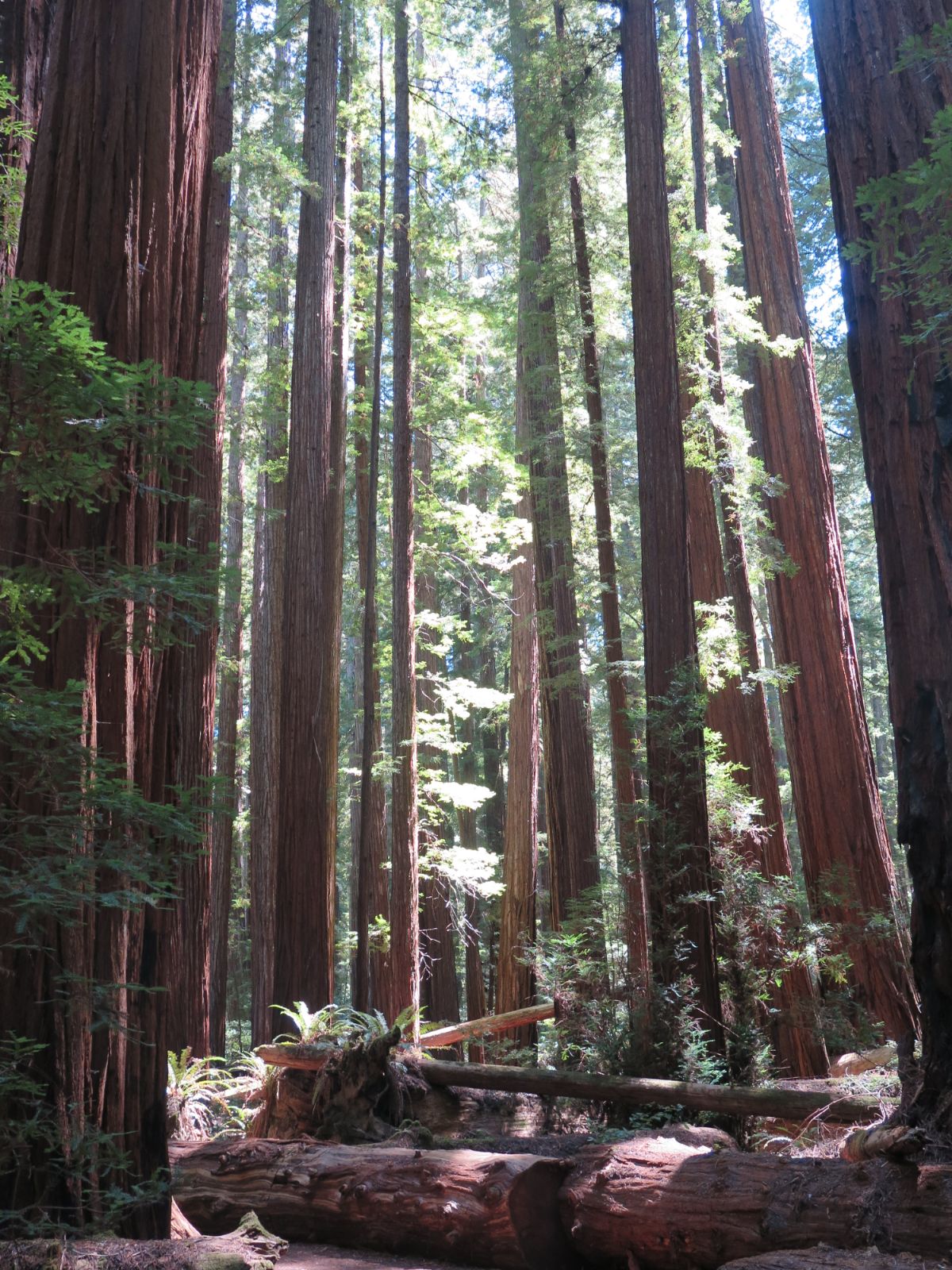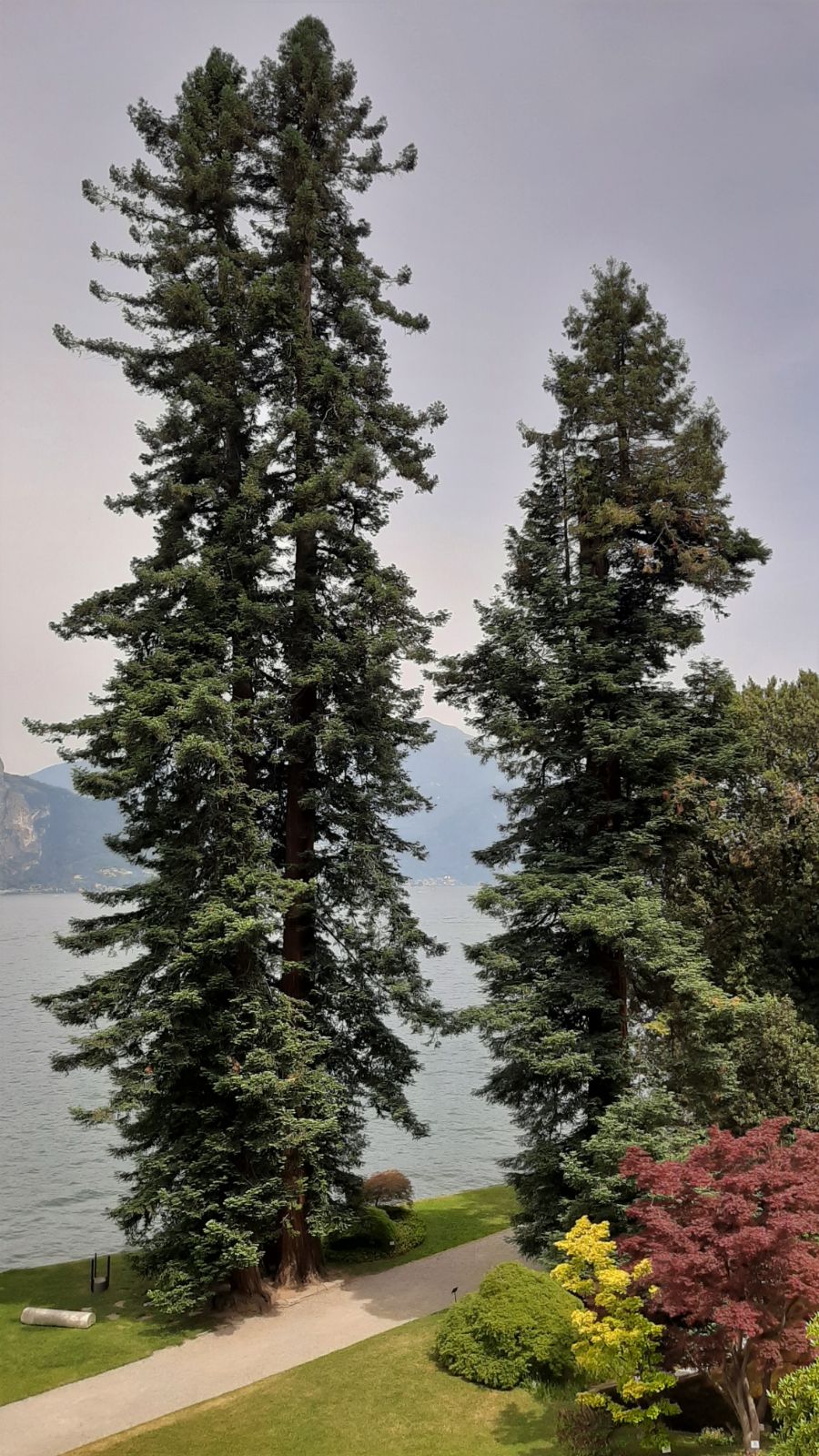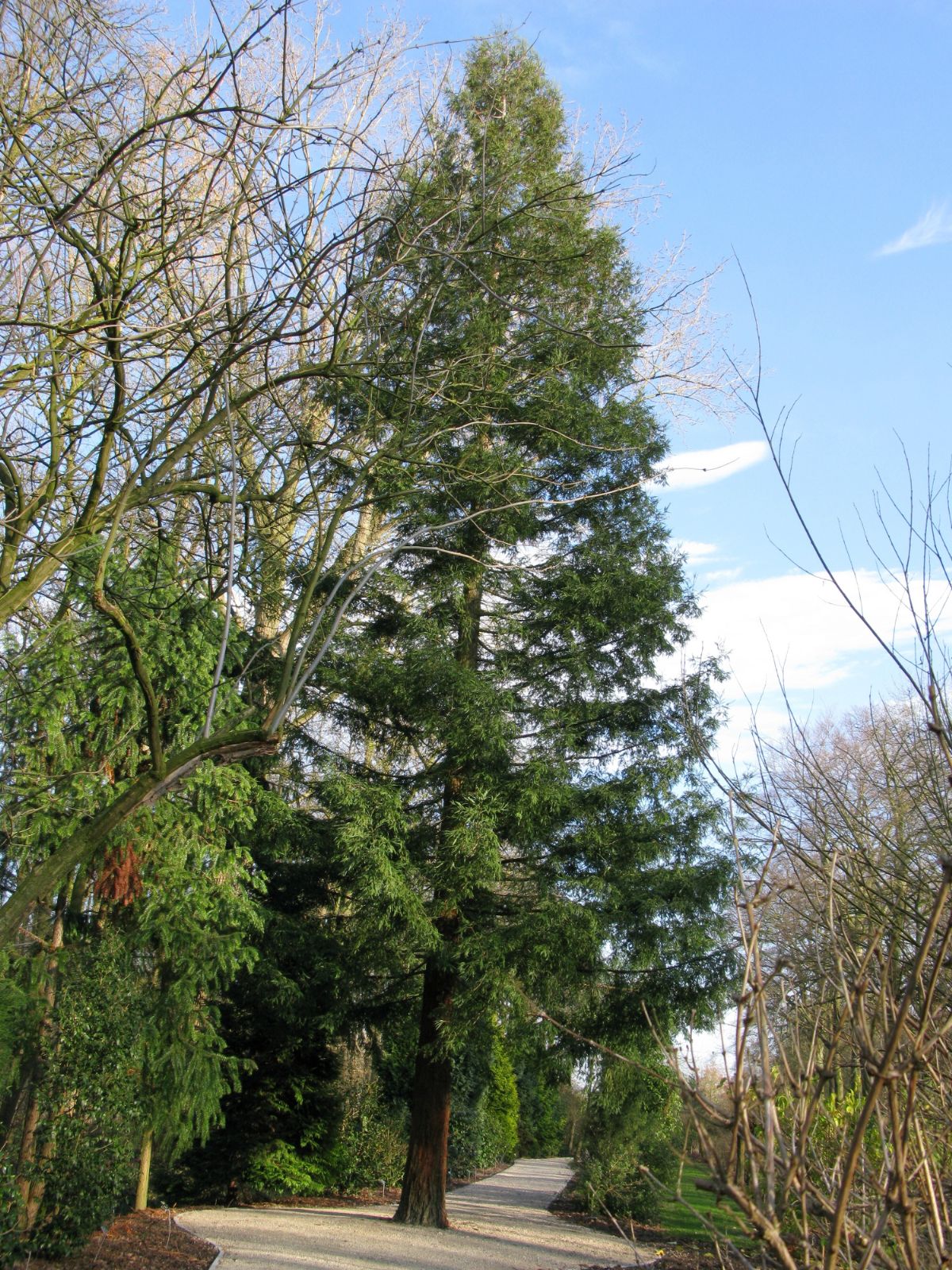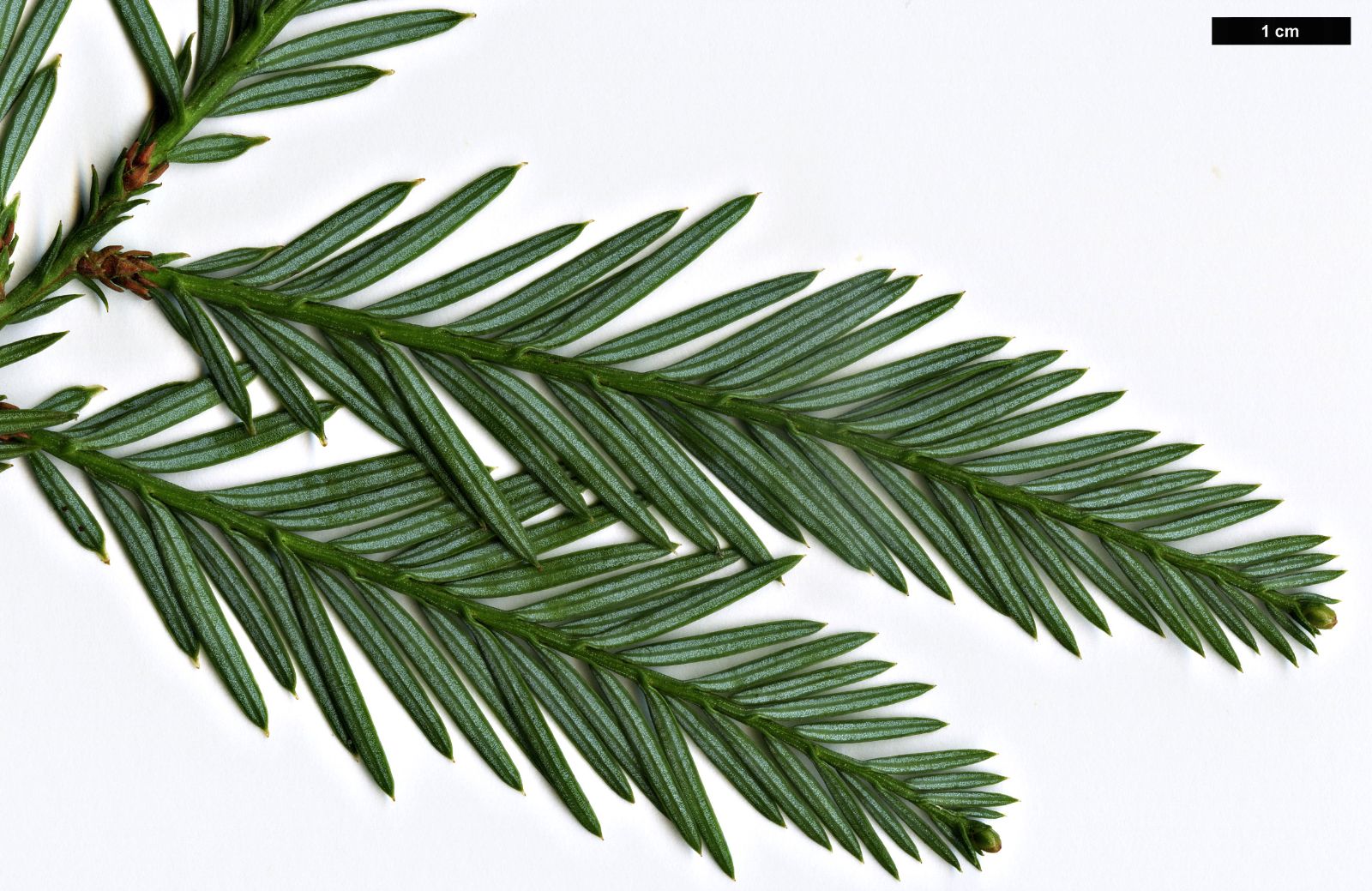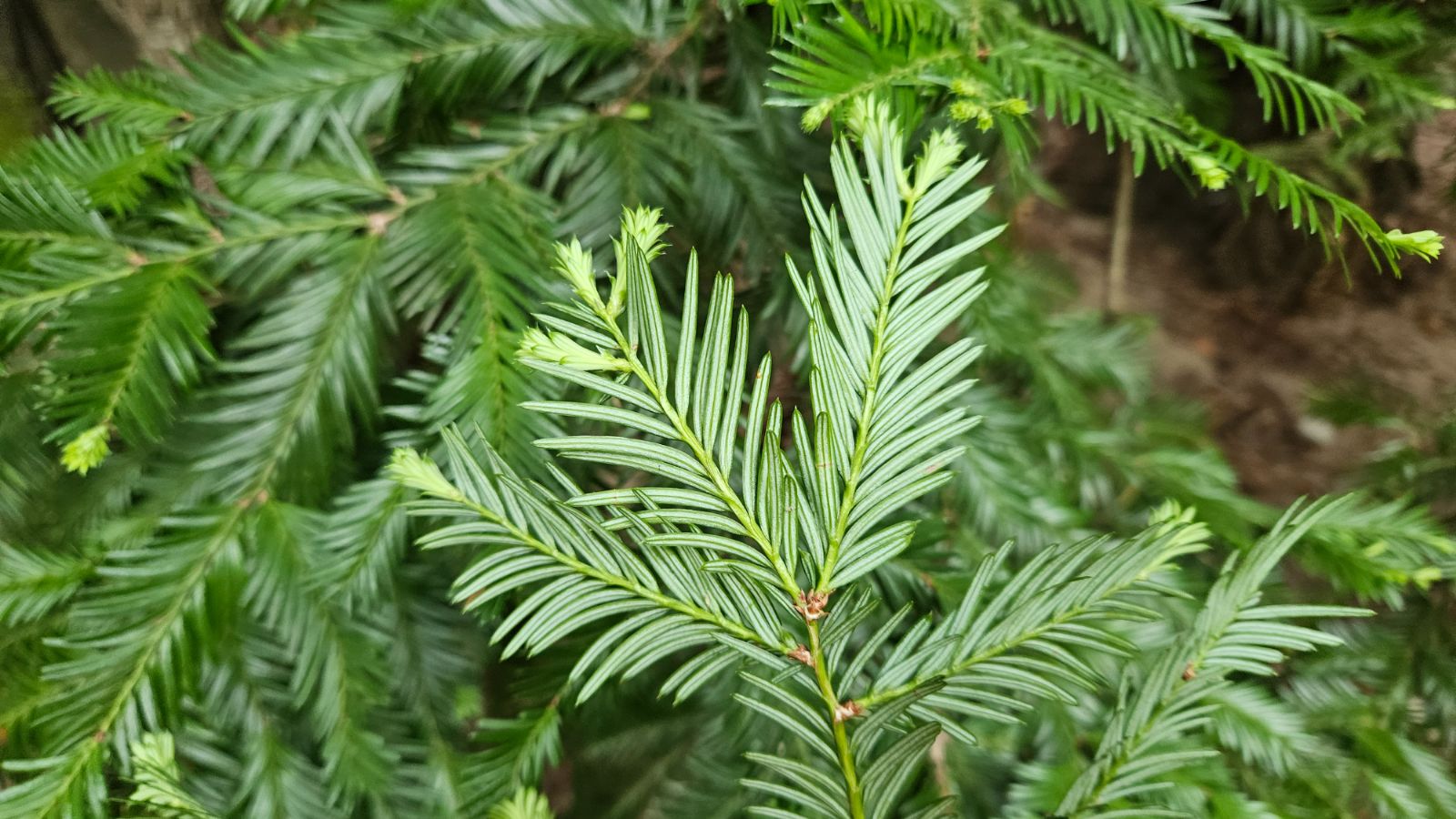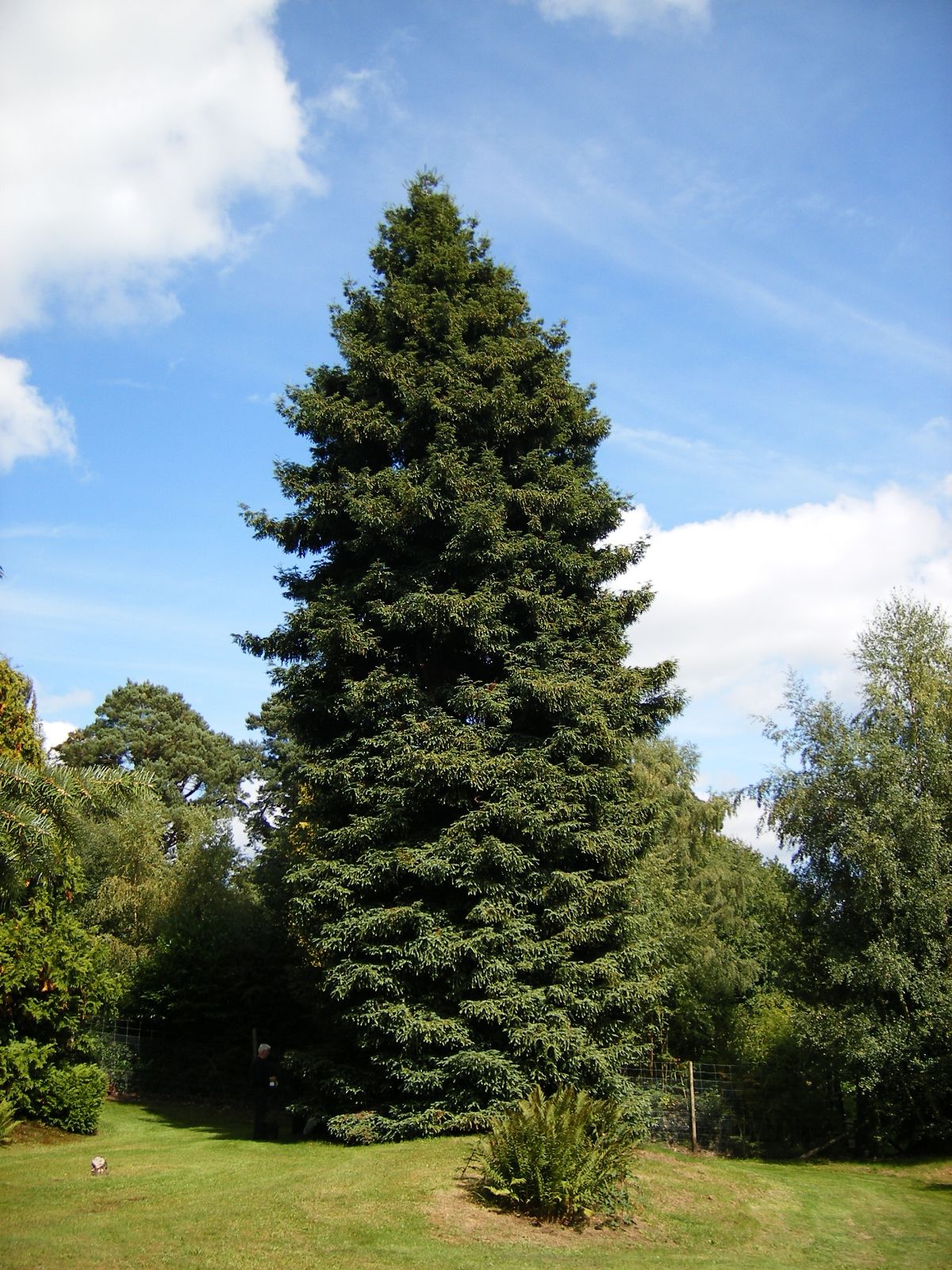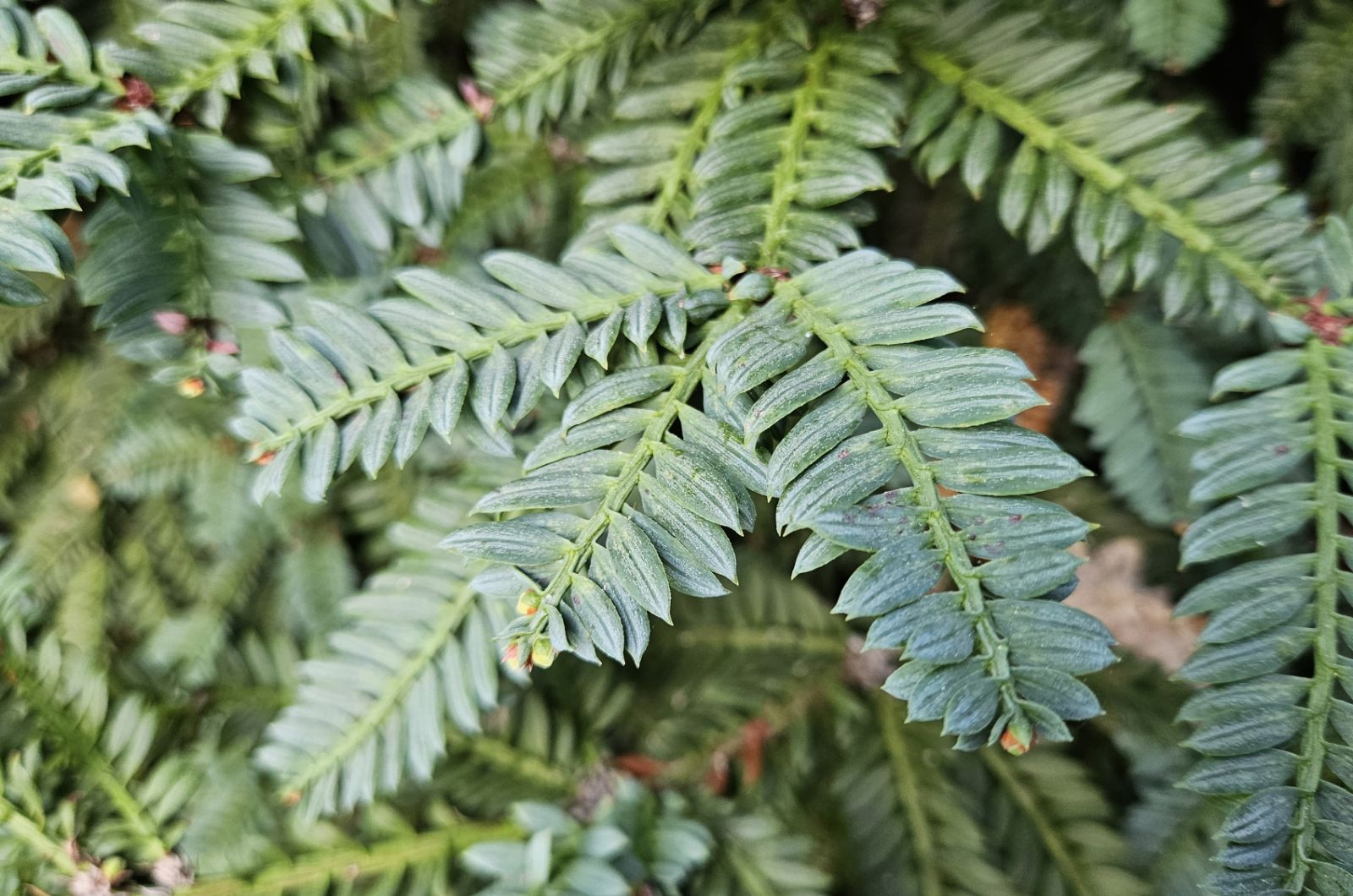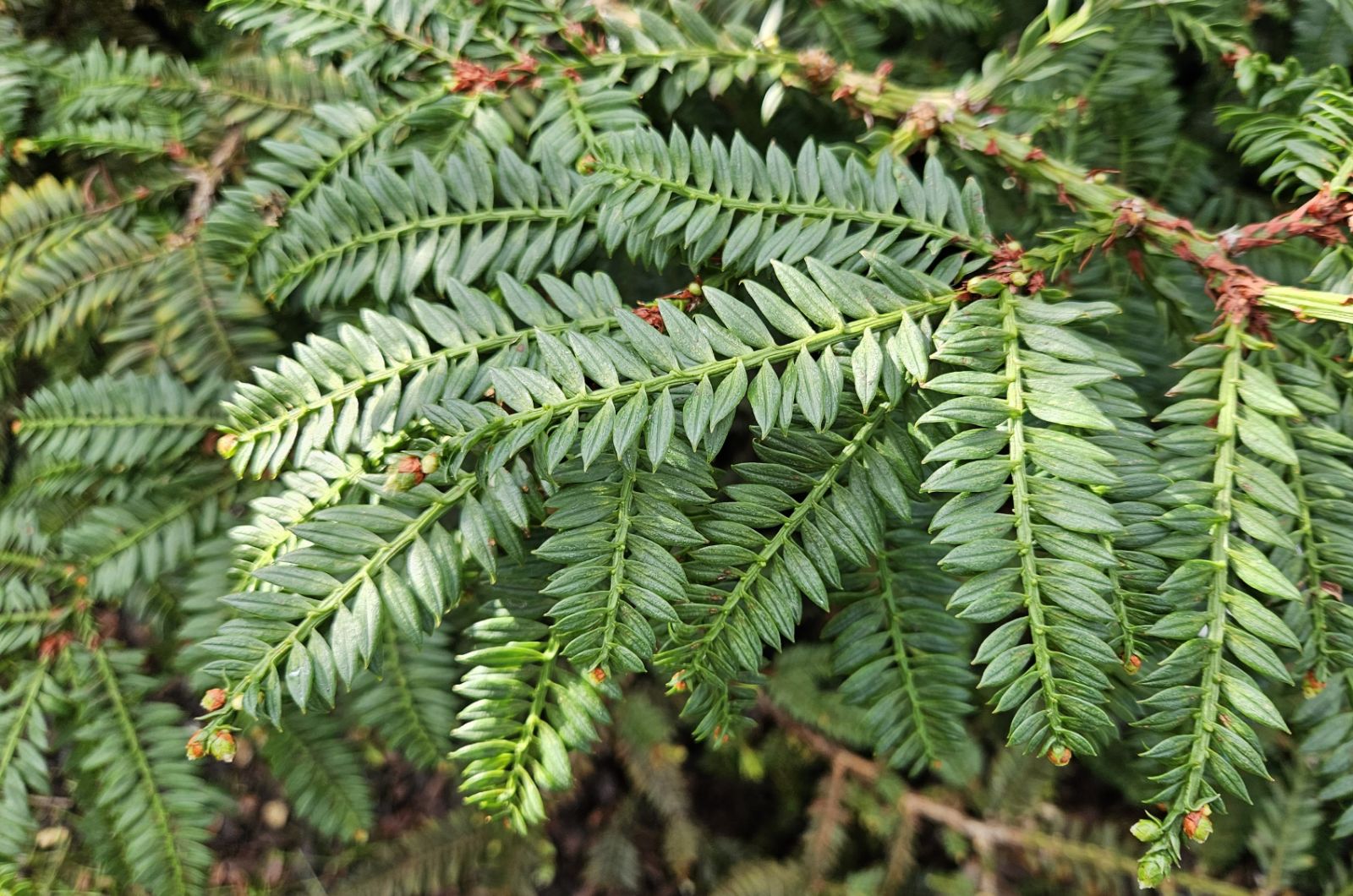Sequoia sempervirens
Sponsor
Kindly sponsored by
a member of the International Dendrology Society
Credits
Tom Christian (2024)
Recommended citation
Christian, T. (2024), 'Sequoia sempervirens' from the website Trees and Shrubs Online (treesandshrubsonline.
Genus
Common Names
- Coast Redwood
- California Redwood
- Redwood
- Séquoia à feuilles d'if
- Küstenmammutbaum
- secuoya roja
Synonyms
- Condylocarpus sempervirens Salisb. ex Carrière
- Gigantabies taxifolia J.Nelson
- Schubertia sempervirens (Lamb.) Spach
- Sequoia pyramidata Carrière
- Sequoia religiosa C.Presl
- Sequoia taxifolia K.Koch
- Steinhauera sempervirens (D.Don) Voss
- Taxodium nutkaense Lamb. ex Endl.
- Taxodium sempervirens D. Don
Infraspecifics
- 'Adpressa'
- 'Alba'
- 'Alba Variegata'
- 'Albospica'
- 'Aptos Blue'
- 'Argentea'
- 'Balaton'
- 'Big Bonsai'
- 'Budapest Zoo'
- 'Cantab'
- 'Compacta'
- 'Don's Gold Strike'
- 'Eggli Prostrata'
- 'Elegans'
- 'Emily Brown'
- 'Filifera Elegans'
- 'Filoli'
- 'George Itaya'
- 'Glaucescens'
- 'Gracilis'
- 'Henderson Blue'
- 'Kelly's Prostrate'
- 'Kenwood'
- 'Kools Variegated'
- 'Korbel KT'
- 'Latifolia'
- 'Lawsoniana'
- 'Les Barres'
- 'Los Altos'
- 'Los Gatos'
- 'Martin'
- 'Monty'
- 'Mr Happy'
- 'Mt Loma Prieta Spike'
- 'Nana Pendula'
- 'Pendula'
- 'Prostrata'
- 'Santa Cruz'
- 'Santa Rosa'
- 'Simpson Silver'
- 'Soquel'
- 'Swarthmore Hardy'
- 'Variegata'
- 'Winter Blue'
Other taxa in genus
Monoecious, evergreen, coniferous tree to 100–115+ m tall, trunk monopodial, straight, massive, the base occasionally buttressed but the bole not flaring as in Sequoiadendron; 6–7(–9) m dbh in the largest individuals, capable of resprouting after damage which may result in multi-stemmed trees. Bark up to 30 cm thick on the bole of old trees, reddish-brown to brownish-grey, fibrous, exfoliating in long, thin strips, deeply fissured with age. First order branches large, spreading, downswept except in the upper crown (ascending), often with numerous reiterations in old trees, forming a conical-pyramidal crown in young trees, later columnar, and latterly irregular and rounded to flat-topped; second order (foliage) branches usually spreading horizontally with densely set ultimate branchlets 3–12 cm long, green at first, later reddish brown, but obscured by decurrent leaf bases. Leaves spirally arranged, linear, flattened, decurrent; on shaded shoots pectinate, c. 20–25 × 3 mm in the middle part of the shoot (shorter at the base and apex); in the upper crown very short (c. 5 mm) assurgent to partly appressed; margins entire; apex acute; green to grey-green or rarely glaucous, vivid and darker above, pale below, the undersides with two whitish stomatal bands separated by the midrib. Pollen cones borne in the axils of terminal leaves, solitary, subglobose, 2–5 × 1–4 mm, with 6–12 scales each with 2–6 globose pollen sacs. Seed cones terminal on short branchlets, oblong to subglobose, 13–30(–35) × 13–18 mm, maturing in one year, green at first, maturing purplish- then reddish-brown, opening on the tree then later falling often with the subtending branchlet. Bract scales peltate, woody, persistent, 15–30 helically arranged, mostly parting when cone matures, distal parts rhomboid, 6–10 × 4–5 mm with a central depression, proximal part narrowing to a pedicellate base. Seeds 60–100 per cone, 3–6 × 2–4 mm, flattened with 2 wings c. 1 mm wide forming a more or less continous margin. Cotyledons 2(–4), when 4 the second pair is much shorter than the first. The only known hexaploid (2n=6x=66) in conifers. (Farjon 2017; Watson & Eckenwalder 1993).
Distribution United States Confined to a narrow belt (the so-called 'fog belt') along and close to the Pacific coast, never more than c. 60 km from the ocean, from Monterey County, California north to Curry County, SW Oregon.
Habitat Sequoia is a key component of a distinctive lowland forest type which it dominates throughout its range, typically on moist but well drained, alluvial soils. The climate is characterised by cool summers with frequent fogs and mild winters with high levels of precipitation. Pure stands are frequent but more often it occurs in mixed forests with common associates including Pseudotsuga menziesii, Acer macrophyllum, Lithocarpus densiflorus and Umbellularia californica. In the northern part of its range the conifers Abies grandis and Tsuga heterophylla (and very locally Chamaecyparis lawsoniana) also occur. Sequoia is distributed over an altitudinal range from sea level to <1000 m asl with the majority of stands below c. 300 m asl. Above c. 750 m asl Sequoia becomes a minor component of relatively species rich forests.
USDA Hardiness Zone 7-9
RHS Hardiness Rating H5
Conservation status Endangered (EN)
Taxonomic note Sequoia and Sequoiadendron are amply distinct morphologically, and occur in very different habitats, but a slew of soundalike common names ensures they are regularly confused in conversation, especially in the UK. Sequoia, the Coast Redwood or to some simply the Redwood, occurs in expansive forests in the so-called fog-belt along or near to the Pacific coast, while Sequoiadendron, the Sierra or Giant Redwood or Giant Sequoia or Wellingtonia or Big or Mammoth Tree, occurs at middle-elevations in the Sierra Nevada in highly localised groves. We attempt to stick to ‘Coast Redwood’ below, except when quoting others, etc.
Sequoia sempervirens is one of the natural wonders of the world, attaining staggering and record-breaking sizes in native forests on the Pacific seaboard of the United States. Like its eponym Sequoiadendron giganteum, Coast Redwood has long attracted the attentions of scholars and researchers, and extraordinary discoveries about this tree and its habitat continue to feature regularly in the scientific and popular press.
Indeed, such is the wealth of research on the biology, ecology and natural history of Sequoia that entire books can – and have been – written about this single species, such that it is impractical to provide more than a brief overview of these aspects here, in a work focused on horticulture. For a more in-depth introduction to Sequoia biology, readers are directed to Chris Earle’s excellent account on his website The Gymnosperm Database and to references therein, especially the wide-ranging 2001 publication Coast Redwood: a natural and cultural history (Barbour et al. 2001). What follows here is intended as a sample of some of the more interesting aspects of this tree’s natural history, and as useful context for the horticultural discussion which forms the second part of this article.
Throughout its c. 750 km north-south range Coast Redwood is rarely found more than 50 km from the ocean and most forests occur below 300 m asl, although stands are known up to just above 900 m (Farjon & Schmid 2013). Most of this area falls within the so-called fog belt, an area of relatively cool, humid summers with regular, often heavy fogs, and mild winters with abundant precipitation. These summer fogs are an important part of the ecology of this region and are particularly significant for Sequoia; transpiration from the humid air via the foliage in the upper crown partly accounts for their ability to attain the huge heights for which they are so well known.
Generations of dendrologists have known Sequoia sempervirens as the tallest growing tree in the world; this has been true for some time but in the past the tallest Pseudotsuga menziesii were even taller, to 119.78 m (Debreczy & Rácz 2011), but these were logged by the end of the 19th century (Mitchell 1996) and Eucalyptus regnans, with the tallest accurately measured specimen at 114.3 m, runs it a close third (Carder 1995). The tallest known Sequoia, named Hyperion – indeed, the tallest extant tree in the world – was measured in 2019 at 116.07 m tall (Sillett et al. 2021); thirty six other individuals have been measured at over 110 m tall, the majority of them in Humbolt Redwoods State Park and Redwood National Park, and as of April 2022 there were over 2585 individuals over 100 m tall distributed throughout most of the natural range (Earle 2023).
The best-preserved forests and the tallest trees have become perhaps some of the most intensively studied on the planet, with just about every aspect of their biology and ecology investigated and reported at some stage. Like Sequoiadendron, part of the appeal of Sequoia is not just the magnificence of individual trees and forests but their fragility and that of the ecosystems they occur in, and an acute sense of urgency in preserving what remains. An enormous area of Sequoia was cut in ‘a frenzy of logging’ (Earle 2023) that lasted nearly two centuries from the late 18th century, a peak of activity coinciding with the California gold rush of the 1850s and lasting nearly a century. Perhaps only 5% of the original expanse of old-growth forest remains – ‘table scraps’ as Robert Van Pelt eloquently puts it (Van Pelt 2001) – and it is astonishing to think that the last old-growth grove to be felled was cut as recently as 1990; fortunately, all remaining old-growth forest is now protected (Farjon & Schmid 2013; Earle 2023).
Sequoia is one of very few conifers to resprout from old wood – and in particular from lignotubers forming ‘massive, largely subterranean swellings’ (Farjon 2017) – which it does readily after major disturbance such as fire, which is increasingly common in the southern part of its range, or even after felling. This accounts for the extensive areas of secondary forest throughout its range, many of which are also now protected. To the uninitiated visitor yet to see intact old-growth forest, even these areas of regenerating Sequoia are staggering to behold, but a visit to an old-growth forest is a pilgrimage every dendrologist should make at least once in their lifetime.
Among the consequences of Coast Redwood’s ability to resprout is that trees often grow in clonal groups – several large stems can represent the same genotype. Furthermore, recruitment from seed, despite the copious amounts that can be produced, is an exceedingly rare occurrence (unlike in Sequoiadendron) with the vast majority of ‘seedlings’ in disturbed areas arising from lignotubers. In many such instances these young shoots will benefit from extensive connected root systems and associated canopy trees providing ample supplies of water and nutrients, which may partly explain Coast Redwood’s fast rate of growth and competitive advantage over so many of its associate species and other aspects of its biology, such as its extraordinary shade tolerance as a young tree (Earle 2023). This also explains how so called albino redwoods, devoid of chlorophyll, are able to survive in nature, but not in horticulture unless grafted onto typical rootstocks that retain some normal green shoots.
Old-growth forests have naturally been the focus of much research into Sequoia biology and especially in recent decades these have revealed some remarkable facts, including that ‘on a unit area basis, redwood forests have the highest biomass loadings of any ecosystem on earth’ (Earle 2023). This statement should probably be qualified by the observation that few forest ecosystems have been as intensively studied as these, but on the other hand, very few tree species reach comparable sizes or grow at such high density. In recent years some of the most fascinating research into Sequoia has focused on canopy ecology; much of this work has been coordinated by Professor Steve Sillett, inaugural Kenneth L. Fisher Chair in Redwood Forest Ecology at Humboldt State University. With a wide range of collaborators Sillett has shone a light on this hitherto hidden world, effectively an entire forest ecosystem in the upper canopies of old-growth Sequoia forests, supporting entire animal and plant communities over 60 m above ground level. Also notable is the observation, now made by several individuals, that in the upper reaches of the highest canopies, Coast Redwood leaves become reduced and almost scale like, presumably an adaptation to reduce moisture loss (B. Jones pers. comm.). New discoveries continue to be made lower down, too; the fungus Redwood Stubble, Calicium sequoiae, was described to science in 2008 having been discovered growing between 20–80 m above ground level on the fibrous bark of trees in old-growth, low-elevation redwood forests (Reese Næsborg 2021).
These sorts of revelations have helped to keep Sequoia in the spotlight, but this species is no stranger to fame. Sequoia had a starring role in Star Wars: Episode VI – Return of the Jedi when several Coast Redwood forests were used as locations for the fictional forests of Endor. What many Star Wars fans do not realise, however, is that most of the filming took place in a stand of trees belonging to a timber company, and this stand was felled shortly after filming was completed! Other stands used in the production have survived and remain popular destinations with movie fans (Earle 2023). One of Coast Redwood’s more recent television appearances was on the 2022 BBC series Green Planet with Sir David Attenborough (BBC 2022). Attenborough draws attention to the spectre of climate change, which in the context of Sequoia forests is beginning to disrupt the summer fogs that are such an important aspect of its ecology. More frequent and intense fires are another growing threat to its long-term survival.
When the last IUCN species conservation assessment of Sequoia took place, in May 2011, it was rated ‘Endangered’ but the phrase ‘climate change’ did not appear once in the assessment (Farjon & Schmid 2013). This is a startling example of how quickly conditions are changing all around the world, and just because Sequoia has routinely lived to over 2000 years of age and grown to heights of over 100 m is no guarantee that it always will. Whilst difficult to measure, climate change impacts will surely feature prominently when Sequoia is reassessed, although a reduction in the severity of threat to ‘Vulnerable’ or even ‘Near Threatened’ is predicted by Philip Thomas of the International Conifer Conservation Programme who observes that the use of the A-criterion in the 2011 assessment was poorly evidenced and better suited to an ecosystem-level assessment (P. Thomas pers. comm. 2023).
Sequoia sempervirens in horticulture
Sequoia has been extensively planted as an ornamental tree in appropriate climate zones around the world since the middle of the 19th century. Growing near the coast, the very early European explorers in California would have encountered it, but the earliest written account appears to be that of Father Juan Crespi, a Friar with the Spanish Portolá expedition of 1769–70; the Czech botanist Thaddäus Haenke encountered it later, in 1791, and made a detailed botanical description (Earle 2023). The British botanist Archibald Menzies collected specimens whilst with the Vancouver expedition of 1791–1795; the name Taxodium sempervirens was later founded on one of Menzies’s specimens which is now preserved in the British Museum herbarium (Farjon 2017).
Quite who introduced Coast Redwood to European cultivation, and when, is open to debate. One theory has it that Thaddäus Haenke’s collections included seed and that these resulted in a very small number of living trees in early 19th century Spain; this is possible, but the evidence, at least as summarised by Earle (2023), is tenuous. More likely is the generally held view that Russian collectors introduced seed from ‘Russian establishments’ such as Fort Ross in Sonoma, maintained whilst California was part of Mexico, which they introduced to European Russia during the late 1830s and/or early 1840s. A proportion of this seed was passed on to neighbouring European nations. This is certainly how Sequoia was introduced to Britain at least, when Dr Fischer of the St Petersburg Botanical Garden sent seed on to the Knight & Perry nursery in Chelsea, London in 1843 (Mitchell 1972; Elwes & Henry 1906–1913).
Knight & Perry was likely the source of the earliest examples to be planted in British collections, including a tree growing at Holker, Cumbria, which was c. 80 cm tall in 1845, and a ‘grafted tree’ planted at Dropmore in that year which was c. 5.5 m by 1851 (Elwes & Henry 1906–1913). (This curious observation begs the question ‘grafted onto what?’ Unfortunately this is not recorded. At the time the species was considered to belong in the genus Taxodium, so perhaps onto Taxodium distichum? Perhaps onto another Sequoia sempervirens, but why bother to do that? Anyway to achieve 5.5 m so quickly suggests good compatibility, so it would be fascinating if this information ever came to light.)
Like so many conifers from the Pacific Northwest, Sequoia was found to be ideally suited to the maritime climate of the UK and Ireland and young trees grew extremely rapidly in the milder and wetter western regions of these islands, the very best specimens – once into their stride – increasing their height by over 1.2 m per year and girth by over 10 cm per year (Mitchell 1972). In cold and exposed areas, however, growth is slower, and trees are susceptible to frost damage, especially when young, and even in the early 21st century it is not uncommon for young trees planted out in cold areas, such as inland parts of Scotland and the north of England, to succumb to a particularly cold winter or harsh late frost (pers. obs.). Spring planting is advised in cold-winter areas.
This youthful vulnerability has been an obstacle to establishing Sequoia in many colder regions, especially in continental climate zones including much of the midwest and eastern United States, but in appropriate areas it has become quite commonly grown, as the relatively numerous examples over 40 m tall in Europe testify. These include individual specimen trees in arboreta, and others planted in groups within forests or woods, and it is in these sheltered situations where trees are naturally drawn up by their neighbours that the very tallest cultivated trees are now being discovered, such as several over 40 m in the Exotenwald, Weinheim, Baden-Württemberg, Germany, considerably taller than most open-grown trees in the same region (monumentaltrees.com 2023).
In a totally different climatic zone, but remarkable nonetheless, is a specimen tree 57 m × 1.37 m dbh in 2017 in the grounds of the Bussaco Palace Hotel in Luso, north of Coimbra, Portugal; this tree stands in good company with two others both over 50 m and a specimen of Eucalyptus regnans 64.9 m tall (monumentaltrees.com 2023). There are many examples in southern Europe; the climate around the Italian lakes is ideally suited to Sequoia, but the Luso example, along with a mass planting of over two hundred specimens, many in excess of 40 m, in the grounds of Castello di Sammezzano in Regello, Tuscany, Italy attests to their ability to cope with heat so long as ample moisture is available at the roots (monumentaltrees.com 2023).
France is home to many fine specimens; among the tallest is a group of closely planted trees on a slope in the Arboretum Domanial de la Jonchère Saint Maurice near Limoges in western France, several are over 60 m while the tallest in 2021 was 63 m × 1.22 m dbh (monumentaltrees.com 2023). Heights further north and east in Europe, in the Netherlands, Germany and beyond, rarely match those achieved in milder and more humid western areas where the influence of the Atlantic Ocean is stronger. In Norway and Sweden Sequoia is confined to western coasts, where the proximity of the sea mitigates the otherwise continental climate; perhaps the most northerly examples in the world are those growing at Bergen Botanical Garden, Norway but it is interesting to note that the oldest accession here only dates from 1988; it will be interesting to follow their progress here in a changing climate (University of Bergen 2023).
In North America Michael Dirr cautions that Sequoia will ‘never perform in eastern states as it does in native habitat or [the] British Isles’ (Dirr 2009), but he does add it will perform ‘reasonably well’ on the east coast, although it grows slowly there and rarely to more than 20 m. In the southeast Sequoia will hold ‘good green needle color [sic.] better than many evergreens through winter’ (Dirr 2009). The west coast is a different story, of course, and here Sequoia is often planted within and beyond its native range, including in the guise of the various named cultivars (see below); a few of these are somewhat hardier than the type and are perhaps more widely grown in the east as a result.
The tallest cultivated trees outside its native range are in New Zealand. An experimental forest plot was laid out in 1901 in Whakarewarewa Forest near Rotorua, on New Zealand’s North Island. Following the First World War the Coast Redwood grove was preserved as a memorial to New Zealand’s fallen forest service personnel, and in 2017 the tallest tree in the grove measured a staggering 73.4 m × 1.58 m dbh; at that time seven other trees in the grove exceeded 70 m and one hundred more exceeded 60 m (monumentaltrees.com 2023).
Whilst the rate of growth slows as trees age and reach an optimum size within the limits of the environment they are planted in, keeping pace with Sequoia statistics is no mean feat, not least because the tallest can be very difficult to accurately measure. When the publicly available database of the Tree Register of Britain and Ireland was last researched for this article in October 2023 only six individuals were over 50 m tall, but with over ninety others in excess of 40 m, with measurement dates in some cases stretching back to the mid-2000s, it seems certain that several more will already have crossed that threshold, and many of the statistics quoted here for various countries will soon be out of date. For now, the Longleat Estate in Wiltshire, UK, may claim the tallest Redwood in the UK or Ireland at 56.2 m × 1.73 m dbh in 2021, when the height was confirmed by a team of climbers from Sparsholt College (Tree Register 2023). It should be noted that much shorter trees may have considerably larger girths, such as one at Woodstock, Kilkenny, Ireland, which had a dbh of 2.68 m in 2017 with a height of ‘only’ 38.8 m (Tree Register 2023).
Besides being grown in milder regions the best trees have in common a sheltered location on moderately fertile, deep, humus-rich, moist but well drained soils. Exposure, even in milder districts, will often result in the loss of tops at various stages, and while this is less of an issue in a mature tree where a few metres more or less makes little difference, such disfigurement can be most unsightly in a vigorous young tree, especially in an arboretum setting. This is one argument for pruning out competing leaders, at least while trees are small enough to make this a practical proposition.
Although a good deep brown earth soil is ideal it is far from compulsory. At Pampisford, Cambridgeshire, UK Sequoia has been successfully established on shallow soils over chalk (although Bean (1981) suggested these were inappropriate), and at Colesbourne Park in Gloucestershire it thrives in almost no soil over broken oolitic limerstone, the famous ‘Cotswold brash’. Indeed, Sequoia is a better prospect than Sequoiadendron on chalk soils, but trees on chalk or soils prone to drying out generally will benefit from irrigation whilst establishing. The species will also succeed on very shallow, moist acid soils, such as those that prevail at Benmore Botanic Garden in Argyll, Scotland, where the best examples are over 50 m tall (pers. obs.; Tree Register 2023). Only the driest and truly waterlogged sites are wholly inappropriate.
Sequoia has a mercifully short rollcall of significant pests and diseases (Dirr 2009). Wild trees have been shown to be a host for Sudden Oak Death (Phytopthora ramorum) but so far this does not appear to pose a significant threat (Lucas, Parke & Valachovic 2009). Sequoia is vulnerable to several plant pathogens, notably the Botryosphaeriaceae fungi Botryosphaeria dothidea and Neofusicoccum spp., especially N. australe, which have been shown to be major factors in the decline of planted trees in California where drought stress is common (Aćimović et al. 2018). Such fungi are particularly common in a horticultural context where trees are subject to injury from pruning, for example, and where drought stress is likely to increase susceptibility (these fungi are also involved in the significant decline of Sequoiadendron in Europe, q.v.). In a northern European context though, browsing animals, and especially deer, may be the greatest enemy. The soft bark makes young trees vulnerable to rubbing and they can be quickly ring barked. If the damage is slight the tree will quickly recover if further damage is prevented, although it is not uncommon for an animal to girdle a young tree in a single sitting. In such cases plants will often resprout from the base, and whilst a single leader can be selected the tree will be inclined to throw out suckering shoots from the base ever-after (pers. obs.).
In considering the pest and disease issues known to affect Sequoia, the results of a recent, multi-year project examining its genome are particularly interesting. In 2017, the Save the Redwoods League commissioned a project to sequence the genomes of Sequoia and Sequoiadendron. Among the many interesting results is that ‘When comparing the coast redwood genome sequence to that of other conifer species, researchers found hundreds of gene families that are unique to the coast redwood. Many of these are genes that help the trees respond to stress and play a role in resistance to fungal disease, detoxification, repair after injury and the synthesis of flavonoids, which help fight stress on the cellular level’ (Save the Redwoods League 2021). (The study also showed that Sequoia’s hexaploidy is the result of autopolyploidy (i.e. a single ancestral species) and not due to hybridisation (Neale et al. 2022, and see genus article)).
Propagation by seed should be the preferred method, with no preatreatment necessary; semi-ripe heel cuttings will root easily enough on a mist bench or under plastic with the application of a little hormone and bottom heat when rooting rates of c. 70% can be expected (Dirr 2009); when good material is selected rooted cuttings will usually develop a good leader after a year or two with staking (pers. obs.). Cultivars should be vegetatively propagated in this way and may also be grafted (Auders & Spicer 2012) but Dirr notes that many named cultivars exhibit reduced rooting rates compared to the species (Dirr 2009) . Given their very fast rates of growth Sequoia can quickly become pot bound when grown in conventional pots; cultivation in Air-Pot© containers should be specified to prevent this problem.
In the past, at least, souvenir shops in California sold packaged pieces of Coast Redwood burr as a novelty to be stood in a saucer of water to sprout shoots from dormant buds. It seems improbable that any such victims survived to become a tree, but it would be interesting to know of any that were successful.
'Adpressa'
Raised by the French nurseryman André Leroy and named by Carrière in 1867, ‘Adpressa’ is a clone of modest growth with creamy-white young growth in the spring; as plants age this effect can be diluted and is best maintained by frequent, rigorous pruning (Auders & Spicer 2012). Without pruning, plants are prone to throwing up strong vertical stems; the Veitch nurseries later propagated this ‘tree form’ and named it ‘Albospica’ in 1881; this would be the identity of a specimen Jacobson cites under ‘Adpressa’, 28 m tall in a garden in Gloucestershire, UK (Jacobson 1996). Both forms are apparently rather rare in North America but according to Dirr ‘Adpressa’ has the advantage of being slightly hardier than the type (Dirr 2009), although the RHS Encyclopaedia of Conifers suggests it is less hardy (Auders & Spicer 2012).
'Alba'
A clone raised at the Sénéclauze Nursery, France, forming a slender shrub with short spreading branches and pendulous branchlets, the leaves rather short and white at least when young (Auders & Spicer 2012).
'Alba Variegata'
Listed by Auders & Spicer (2012) with the note ‘Shoot-tips creamy white. Listed by Maurice Young in 1875’ but there is no disambiguation with other white-variegated clones, and it may just have been a renaming of another such plant listed here.
'Albospica'
The ‘tree phase’ of ‘Adpressa’ (see above). The feminine name ‘Alba Spica’ was first used by the firm William Barron & Son in 1875 and later described by Veitch (Veitch 1881); the use of two cultivar names for different phases of the same plant was eventually approved under the International Code for the Nomenclature of Cultivated Plants (Auders & Spicer 2012).
'Aptos Blue'
Introduced by the Saratoga Horticultural Research Foundation, California in the mid to late 1970s, this cultivar is commonly grown in North America. The RHS Encyclopaedia of Conifers (Auders & Spicer 2012) describes it as a conical tree with horizontal first order branches, the branchlets pendulous with densely set, dark bluish-green leaves, quite broad relative to their length, but Dirr makes the important distinction that secondary branches are also ‘distinctly horizontal’ and that it is the third-order branchlets that are pendulous (Dirr 2009). The intensity of the blue colouration would seem to vary between individuals and the environment where plants are grown (Jacobson 1996; Auders & Spicer 2012).
'Argentea'
A plant of uncertain origin, listed by E.A. Cope in 1986 and described as having patches of white-variegation on the young foliage, but the cultivar name in Latin form is only acceptable if proved to be published before 1959 (Auders & Spicer 2012).
'Balaton'
A very cold hardy selection raised c. 1915 at the Folly Arboretum, situated on the northern shore of Lake Balaton, Hungary (Auders & Spicer 2012). The influence of the lake has created an extraordinary microclimate, more akin to the Mediterranean region and quite at odds with the continental climate that prevails in most of Hungary; as a consequence, Folly Arboretum grows a great many rare conifers from similar climatic zones, including Pinus monophylla, P. montezumae, Abies pinsapo and Juniperus drupacea (pers. obs. 2019).
'Big Bonsai'
A 2008 introduction from Jan Kools and the Nelis Kools Nursery of the Netherlands, ‘Big Bonsai’ lives up to its name and slowly develops into an upright, conical plant with very small leaves after the first year (Auders & Spicer 2012).
'Budapest Zoo'
A selection from the grounds of Budapest Zoo, Hungary, named by Mesterházy in 1987 for its yellow variegation (Auders & Spicer 2012).
'Cantab'
‘Cantab’ arose as a bud-mutation on a tree of ‘Prostrata’ in Cambridge University Botanic Garden, UK. It was named by Roy Lancaster in 1977 and in its original form it develops into a slow-growing, compact, densely branched small tree with short and very wide leaves, with a length to width ratio of no more than 3:1, but it is often confused and incorrectly labelled both in collections and in the trade (Auders & Spicer 2012).
'Compacta'
Recorded by Nelson in 1866 but probably now lost to cultivation (Auders & Spicer 2012).
'Don's Gold Strike'
A yellow-variegated plant with a moderate growth rate; the variegation is in ‘splashes’ rather than uniformly distributed, like in Calocedrus decurrens ‘Aureovariegata’. It was found by Lance Reiner near Santa Cruz and named for his father, and listed by the Stanley & Sons Nursery, Oregon, in 2002 (Auders & Spicer 2012).
'Eggli Prostrata'
A spreading clone without a leader, in ten years to 1 × 2–4 m (Auders & Spicer 2012).
'Elegans'
A name listed by the firm Peter Lawson & Son, Scotland in 1874, but without additional information (Auders & Spicer 2012).
'Emily Brown'
Recorded by Saratoga Horticultural Research Foundation, California in 1988 as received from an Emily Brown. Auders & Spicer (2012) offer little to distinguish this material from the type, and the name may just have been used to denote its origin.
'Filifera Elegans'
A clone of typical habit but with the ultimate branchlets ‘drawn out to a filamentous tip’ with the leaves ‘gradually becoming shorter toward [the tips] and becoming scale-like only on the whip-like shoots’ (Auders & Spicer 2012). It was raised before 1904 at the Rovelli Brothers nursery, Italy.
'Filoli'
Synonyms / alternative names
Sequoia sempervirens 'Woodside Blue'
Sequoia sempervirens 'Woodside'
Perhaps the most successful and widely grown of the cultivars introduced by the Saratoga Horticultural Research Foundation, California, having been selected at the Filoli Gardens, Woodside, before 1990. Several authors extol the excellent blue colour of the foliage, nevetheless this is a large tree that requires plenty of space; within ten years it may achieve a height and spread of 5 × 3 m (Auders & Spicer 2012; Dirr 2009; Jacobson 1996).
'George Itaya'
An introduction from the Saratoga Horticultural Research Foundation, in commerce since 1975 at the latest but remaining rare. It is a tree of relatively weak constitution, with a sparse, narrow crown (Auders & Spicer 2012). Jacobson (1996) likens it to some forms of Cryptomeria with branchlets clustered together near the branch ends.
'Glaucescens'
Described in the RHS Encyclopaedia of Conifers as ‘A pyramidal plant with short spreading branches and shorter, narrower needles than those of the species. Needles glaucous on both faces’ (Auders & Spicer 2012).
'Gracilis'
A form recorded by Carrière in 1867, distinguished then by its slender branches and leaves narrower than typical (Auders & Spicer 2012), but this has probably long been considered to fall within the variation of the species.
'Henderson Blue'
An upright tree of moderate vigour with striking blue foliage, introduced in or before 1975 by the Saratoga Horticultural Research Foundation, California (Dirr 2009). Jacobson recommends keeping it as a shrub by regular hard pruning due to its ungainly habit when allowed to form a tree (Jacobson 1996).
'Kelly's Prostrate'
A prostrate clone of rather slow growth, with typical foliage. In ten years it may remain a mat less than 20 cm tall and up to 1.2 m across. Listed by Collector’s Nursery, Oregon in 2002 (Auders & Spicer 2012).
'Kenwood'
A strongly glaucous form of rapid growth, but maintaining a relatively compact habit. Introduced by the Stanley & Sons Nursery of Oregon before 2002 (Auders & Spicer 2012).
'Kools Variegated'
An upright tree of modest growth rate, to 30 cm per year, with large splashes of yellow variegation among the mostly typical green foliage. Raised in the early 2000s by Nelis Kools, The Netherlands (Auders & Spicer 2012).
'Korbel KT'
An upright, columnar, relatively slow-growing tree, growing at about half the rate of the species. Some lower branches are upturned near their ends. Found in the wild near Korbel, California by W.J. Libby and K. Tufuor of the University of California, before 2001 (Auders & Spicer 2012).
'Latifolia'
A wide-leaved clone described by Sénéclauze in 1867, based on a plant raised at the André Leroy Nursery, France. The leaves may be up to 4 mm wide (Auders & Spicer 2012).
'Lawsoniana'
Named for the Lawson nursery of Edinburgh, Scotland where it was raised sometime before 1866, ‘Lawsoniana’ is described as being of rigid habit with shorter, stouter leaves than typical (Auders & Spicer 2012). It is not clear whether it remains in cultivation, nor whether it would be considered sufficiently distinct by modern standards to warrant naming.
'Les Barres'
Described by Auders & Spicer (2012) as ‘conspicuous’, this selection, which arose at the eponymous French National Arboretum before 1995, has proved hardier than typical forms of the species and has bluish foliage.
'Los Altos'
Recorded by California’s Saratoga Horticultural Research Foundation in 1967, ‘Los Altos’ is described as a ‘strong-growing, symmetrical, pyramidal tree with light green foliage that later becomes darker’ (Auders & Spicer 2012). Jacobson notes the relatively long branches and the rather coarse texture of the foliage (Jacobson 1996).
'Los Gatos'
Another of the Saratoga cultivars introduced by the eponymous Horticultural Research Foundation in California, during or before 1975. It develops a sparse crown of distinctly upswept branches (Jacobson 1996).
'Martin'
A distinctly cold-hardy selection with bluish leaves in summer, becoming greener through the winter months. Listed by Cees van Ostaayen, Belgium in 2009 (Auders & Spicer 2012).
'Monty'
Synonyms / alternative names
Sequoia sempervirens MAJESTIC BEAUTY®
A densely branched selection that develops into a symmetrical, pyramidal tree with pale blue foliage. Raised prior to 1981 by Monrovia Nursery, California (Auders & Spicer 2012).
'Mr Happy'
A slow-growing, yellow-variegated selection introduced before 2009 by the Oregon firm Bucholz & Bucholz. After ten years it may be only 1.5 m tall (Auders & Spicer 2012).
'Mt Loma Prieta Spike'
Spiky by name and spiky by nature, this cultivar forms an extremely narrow tree with drooping branches, never spreading far from the trunk. In ten years it may be 4.5 m tall with a canopy spread of 1.2 m; proportions not unlike a Serbian Spruce (Picea omorika). It has been in North American commerce since at least 2008 (Auders & Spicer 2012).
'Nana Pendula'
One of very few genuinely dwarf selections, Sequoia sempervirens ‘Nana Pendula’ forms a prostrate mat with spreading, slender, flexible branches, their ends drooping; in ten years it can grow to 0.35 × 2 m. The adult leaves are somewhat glaucous green but the young shoots in the spring are often very pale yellow. It was discovered in the garden at Curragh Grange, Kildare, Ireland before 1923 (Auders & Spicer 2012).
'Pendula'
A weeping selection with a straight trunk as normal, the first order branches widely arching, in turn bearing gracefully pendent or nodding branchlets. It was raised from seed prior to 1899 by the Rovelli Brothers firm in Italy (Auders & Spicer 2012).
'Prostrata'
A spreading dwarf with stiff branches and glaucous foliage, the leaves up to twice as wide as those of the species, but of typical length. It arose as a mutation in Cambridge Botanic Garden, UK, prior to 1949 (Auders & Spicer 2012). Like many dwarf selections of Sequoia it is prone to throwing up strong leaders which will soon dominate a plant if not pruned out; one such mutation was propagated from Cambridge and named ‘Cantab’ in 1977 (see above).
'Santa Cruz'
A tree of typical stature with pendent terminal branchlets. It was recorded by the Saratoga Horticultural Research Foundation in California in 1975 and later named by the Monrovia Nursery (Auders & Spicer 2012). By the late 1990s it remained a rare plant in American gardens (Jacobson 1996).
'Santa Rosa'
Another introduction from the Saratoga Horticultural Research Foundation, California, in American commerce by 1975 where it soon became commonly grown. The foliage is rather pale green and very finely drawn with individual leaves very narrow in proportion to their length. Jacobson likens the foliage to the feathery appearance of Metasequoia (Jacobson 1996).
'Simpson Silver'
A tree with silvery blue upper leaf surfaces. It was selected from a tree growing near Long Prarie Creek, California in 1975 and introduced shortly afterward by the Saratoga Horticultural Research Foundation (Jacobson 1996). Very fast growing, to 7 m in ten years (Auders & Spicer 2012).
'Soquel'
Auders & Spicer (2012) consider this to be a probable synonym of ‘Aptos Blue’, but the American authors Jacobson (1996) and Dirr (2009) treat it as distinct, noting its compact habit, disinclination to sucker, upswept branches, and elegant pale green foliage with somewhat glaucous leaf undersides. It was selected at the Saratoga Horticultural Research Foundation in 1975 and named by Monrovia Nursery by 1981.
'Swarthmore Hardy'
Selected before 2000 from a vigorous, dark-leaved tree growing at Swarthmore College, Pennsylvania, and inferred to be more cold-hardy than the type (Auders & Spicer 2012; Dirr 2009).
'Variegata'
An unusual cultivar with yellow-variegated, bluish-green leaves, more imbricate than typical lending the branchlets a quadrangular appearance. Recorded by Carrière from the Croux Nursery, France, before 1890 (Auders & Spicer 2012).
'Winter Blue'
A vigorous plant, pyramidal in outline, to 4.5 × 2 m in ten years with blue-green foliage in spring and summer, but in winter becoming a much more vivid, almost shining blue. Raised before 2001 by Dirk Winter and put into commerce by Forestfarm Nursery, Oregon (Auders & Spicer 2012). It is now in commerce on both sides of the Atlantic.


